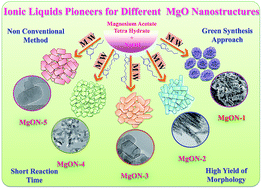Green solvent ionic liquids: structural directing pioneers for microwave-assisted synthesis of controlled MgO nanostructures†
Abstract
Magnesium oxide (MgO) is one of the auspicious metal oxides which attracts much attention because of its superior performance in scientific applications. Controlled facial arrangement of MgO nanostructures with tailored properties is highly important in nanotechnology and nanoscience. Here, various MgO nanostructures were obtained via one-pot microwave (MW)-assisted synthesis in various structural directing ionic liquids (ILs). These selected ILs are based on monocationic and dicationic moieties which consist of N-methyl imidazolium and 3-methyl pyridinium cations with various halide anions. Different designer solvents with respect to their counter anions produced various nanostructures, varying from nanoflakes, interconnected nanoparticles, hexagonal nanoparticles, irregular nanoparticles and nanocapsules. In this method, green solvent ILs not only act as solvent but also act as structural directing agents. In addition, a plausible mechanism of nanomaterial formation under MW irradiation in the presence of ILs was also determined. Formation of hydrogen bonding with favorable π–π interactions by simply tailoring the IL structures by means of MW conditions is the key factor for the development of different morphology. To define the catalytic activity of the prepared nanostructures, a Claisen condensation reaction was performed. The results showed that all the nanostructures have efficient catalytic activity due to their tailored structure, basicity, and surface area. Particularly, a catalytic amount of hexagonal morphology MgO obtained from dicationic [C4(mIm)2Cl2] IL showed 100% conversion and a remarkable 95% selective yield of the respective product. The proposed approach for nanomaterial preparation does not require an additional template and harsh reaction conditions which establishes this as a simple method to reduce the cost of production using environmentally benign solvents.

- This article is part of the themed collection: Ionic Liquids: Editors collection for RSC Advances

 Please wait while we load your content...
Please wait while we load your content...